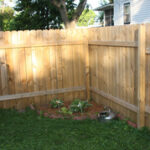If you live in the city, chances are good that you’ll need to purchase a fence permit before constructing a new fence or replacing an old one. Fence permits are purchased through the Planning & Zoning department and can cost $25 and up depending on where you live and the length of the fence.
Of course, most people don’t bother buying a fence permit, thinking that no one at the city will know. The problem with this money saving tactic is that if the fence has been constructed incorrectly, you will be required to tear it down and start again.
What is a fence permit actually for? Fence permits are more than just a way for a city to collect money on home improvement projects. Permits ensure that fences are being built to proper building code.
Before a fence permit can even be issued, there’s a bit of a process a homeowner must follow. The homeowner must first draw up a site plan to accompany the application for the permit. A site plan is a sort-of “aerial view” of a property which includes the house and yard, sidewalks, paths, driveways, trees, and retaining walls. The proposed fence is sketched on top of the site plan to show how the homeowner visualizes the finished project. This site plan is then checked by a planning & zoning officer who will verify that the proposed fence meets building code. If he sees a mistake or doesn’t like the materials being used, he’ll recommend alternatives.
Common fence mistakes DIYers make. Every city has their own building requirements when it comes to constructing a fence, and standards can change with time. This is why homeowners should never guess how a fence should be built simply by looking around his neighborhood. Obtaining a fence permit means that a city employee will ensure that the fence is built properly, and the following types of mistakes avoided:
1. Wrong height. Most cities limit the back yard fence height to 6 feet with stair stepping as it approaches the front of the property. If your proposed fence is too high, the P&Z; officer will recommend the proper height based on the fence’s location in the yard.
2. Wrong material construction. Some cities restrict the type of building material that may be used to construct a fence. Fences made of things like wood pallets, sheet metal, barbed wire, and rotting scrap wood are usually prohibited.
3. Blocks the clear vision triangle. This usually applies to corner properties, and basically means that a fence can’t block the vision of people approaching the intersection. Again, an officer can help a homeowner come up with a way to fence the front yard without impeding vision.
4. Built in the wrong location. Fences usually can’t be built in the setback areas or in the public right of way areas. This is the area where most people seem to trip up when building a fence, assuming that location doesn’t matter. The code officer can help you determine where the setbacks are on your property so that the fence isn’t accidentally built in the wrong spot.
Why getting a fence permit is a good idea. Meeting with a building inspector ahead of a fence construction means that your fence won’t have to be pulled down because it’s too high or too close to the street, driveway, or a utility easement. An officer can address potential problems before the fence is built, which is why buying a fence permit will save you money in the long run.



